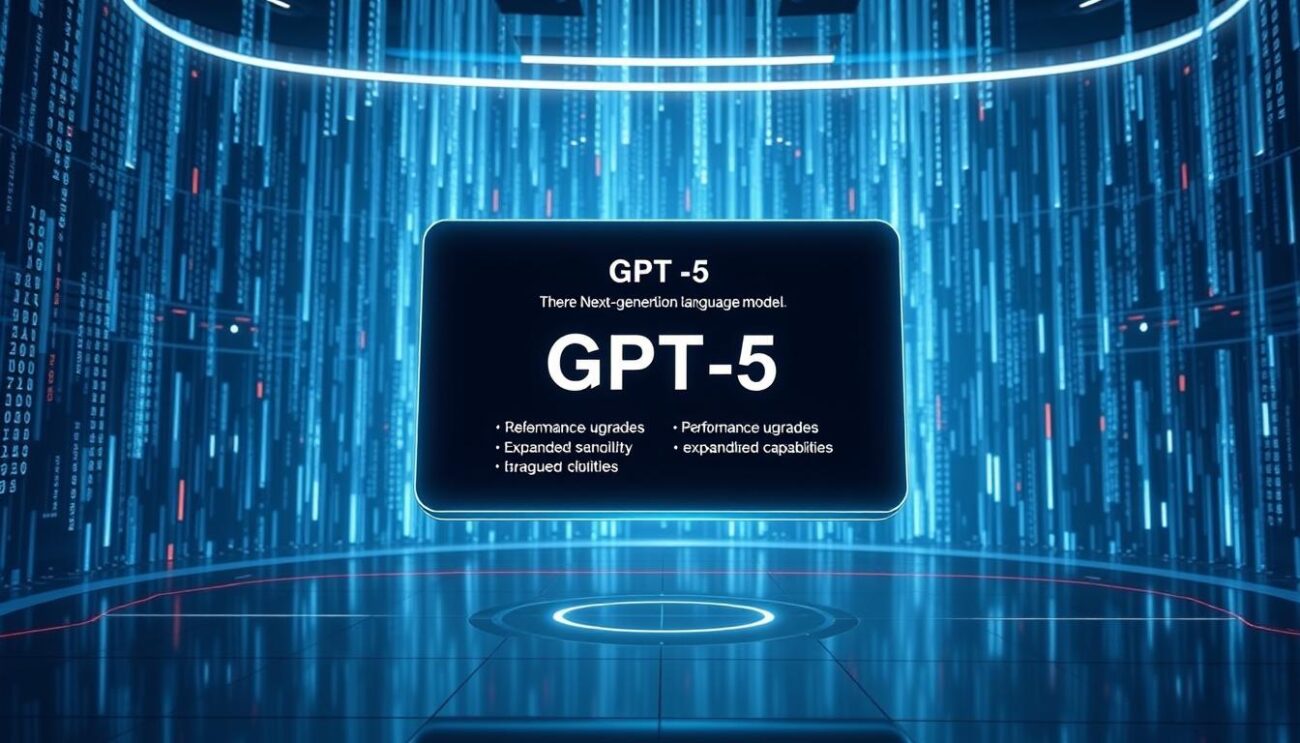GPT‑5 Release Date: Is GPT‑5 Coming Soon? Latest News, Features & 2025 Rumors

GPT‑5 Release Date: Is GPT‑5 Coming Soon? Latest News, Features & 2025 Rumors
Is the release of GPT-5 just around the corner, or is it still a distant dream? As curiosity peaks about the GPT-5 release date, enthusiasts and experts alike are buzzing with speculation on its upcoming features and potential impact on AI technology. With the landscape of artificial intelligence rapidly evolving, understanding these developments is more crucial than ever. Recent updates from OpenAI and AI news sources suggest we might be closer to the next big leap in language models than previously thought. In this article, we will dive deep into the GPT-5 features and explore the GPT-5 rumors for 2025 that have captured the attention of the tech world.
Thank you for reading this post, don't forget to subscribe!
Key Takeaways
- The expected timeline for the GPT-5 release date remains a topic of intense speculation.
- New features and enhancements in natural language processing are anticipated.
- Integrations with other technologies may redefine user interaction.
- Industry experts share their insights on the potential implications of GPT-5.
- Community reactions and predictions regarding GPT-5 are creating a significant buzz on social media.
Overview of GPT-5
The GPT-5 overview reveals a significant leap in the realm of artificial intelligence, marking a critical point in AI advancements. As technology evolves, this new language model is expected to enhance both understanding and generation capabilities. The development of GPT-5 showcases OpenAI’s commitment to refining its AI solutions, pushing the boundaries of what language models can achieve.
This iteration builds upon the successes of its predecessors, promising not only greater accuracy in language processing but also improved contextual comprehension. With the increasing reliance on AI in various sectors, the implications of these advancements could be profound. Users can anticipate more natural interactions with technology, aiding in everything from content creation to customer support.
The significance of the GPT-5 release lies in its potential to redefine standards across multiple industries. As AI continues to carve a niche in daily operations, understanding the overarching trends in language models will be essential for grasping the future of technology. Insightful discussions surrounding these developments can be found in numerous technical reviews and AI journal articles, all underscoring the relevance of OpenAI’s progress in this dynamic field.
GPT-5 Release Date
The anticipation for the GPT-5 release date is generating significant buzz within the tech community. Insights gathered from various sources suggest that the unveiling of GPT-5 may occur in late 2025. Analyzing AI release trends, it becomes evident that OpenAI tends to maintain a consistent schedule between major updates. Understanding previous launch intervals aids in forming accurate predictions for future releases.
Predicted Timeline for Launch
Based on the patterns observed in earlier versions like GPT-3 and GPT-4, the expected timeline for the GPT-5 release aligns closely with established habits of OpenAI. Historical data shows that each major update typically follows a gap of approximately one to two years. As the technology continues to evolve, predictions surrounding the GPT-5 launch center on late 2025, emphasizing the need for careful monitoring of OpenAI announcements.
Previous Release Patterns
Reflecting on the OpenAI launch schedule, the past releases of GPT-3 and GPT-4 reveal interesting insights. The transition between GPT-2 and GPT-3 occurred roughly a year after the former’s introduction, while GPT-4 emerged around a similar timeframe following its predecessor. Observing these patterns contributes to shaping expectations regarding the GPT-5 release date and helps the audience to anticipate any announcements from OpenAI.
Expected Features of GPT-5
The anticipated release of GPT-5 brings excitement over its potential capabilities, particularly in the realms of Natural Language Processing (NLP) and user interaction. As AI technology evolves, the expectations surrounding GPT-5 features focus heavily on advancements that will redefine how machines understand and respond to human language.
Improvements in Natural Language Processing
One significant area of development for GPT-5 will be its NLP improvements. Enhanced contextual understanding and the capability for nuanced responses are at the forefront. These advancements aim to make AI dialogue more fluid and accurate, addressing complexities in human language that previous models struggled with.
Enhanced User Interaction Capabilities
With a focus on user interaction AI, GPT-5 intends to create more personalized dialogue experiences. By analyzing user inputs more effectively, it can tailor responses that seem more relatable and engaging. This shift towards relatability marks a notable evolution in how users can connect with AI systems.
Potential Integrations with Other Technologies
Integration possibilities with existing technologies will further highlight GPT-5’s versatility. Cross-platform compatibility could lead to seamless applications across various software, enriching the user experience and broadening the scope of AI utilization. This trend aligns with the growing demand for cohesive technological ecosystems.
Latest News Surrounding GPT-5
Recent OpenAI updates have sparked a great deal of interest in the tech community, focusing on the anticipated release of GPT-5. Current discussions emphasize significant advancements that the new model may offer. Insights from industry analysts and tech conferences provide a comprehensive view of what the future may hold for this cutting-edge technology.
Updates from OpenAI
OpenAI has made several announcements regarding its ongoing developments with GPT-5. These GPT-5 news items highlight optimizations in the model’s architecture aimed at enhancing performance and user experience. Recent statements suggest a commitment to refining natural language processing capabilities, along with plans for a more interactive platform. Reports indicate that developers are testing various features in anticipation of public feedback.
Confirmed Information From Reliable Sources
Trusted tech journalists have begun sharing insights about OpenAI updates based on credible sources within the organization. Recent articles have outlined specific enhancements intended for GPT-5, focusing on streamlined usability and integration with existing technologies. These tech industry insights emphasize the importance of feedback from the user community as OpenAI fine-tunes the release. Continued attention from experts in the field underscores the significance of these advancements.

GPT-5 Rumors for 2025
The tech community is buzzing with various GPT-5 rumors for 2025, reflecting hopes and anticipations regarding the evolution of AI technologies. Speculations suggest that upcoming innovations in the GPT series may significantly enhance user experience and functionality. Experts within the industry continue to provide insights that shape the ongoing discourse surrounding these developments.
What the Tech Community is Speculating
In recent discussions, tech community speculation has centered on several key areas for GPT-5. Notable points include:
- Improved understanding of context and nuance in conversations.
- Higher processing speed with increased efficiency in outputs.
- Better integration with other AI tools, broadening applications across various fields.
Insights from Industry Experts
Industry insights have played a crucial role in shaping beliefs about the potential of GPT-5. Many experts agree that advancements will likely focus on:
- Enhancing emotional intelligence in AI interactions.
- Expanding multilingual support to reach wider audiences.
- Fostering ethical AI development practices within organizations.
Comparing GPT-5 with Previous Versions
In the evolving landscape of artificial intelligence, comparing GPT-5 with its predecessor, GPT-4, showcases a significant leap in capabilities. Empirical analyses reveal key improvements, particularly in language coherence, response speed, and contextual awareness. These enhancements are quantified through various AI performance metrics, providing a clear distinction between the two models.
Key Improvements Over GPT-4
The GPT-4 comparison with GPT-5 highlights several advancements. These include:
- Language Coherence: GPT-5 exhibits an enhanced ability to generate contextually relevant responses.
- Response Speed: Improved algorithms allow for quicker processing times, resulting in more efficient interactions.
- Contextual Awareness: Better handling of complex queries leads to a more nuanced understanding of user intent.
Performance Expectations
Performance expectations for GPT-5, based on current technological trends, suggest its superiority in handling diverse tasks. When considering AI performance metrics, the following table provides an overview of the expected improvements:
| Feature | GPT-4 | GPT-5 |
|---|---|---|
| Language Understanding | High | Very High |
| Response Time | 2 seconds | 1 second |
| Multi-turn Conversations | Moderate | Advanced |
| Factual Accuracy | 85% | 95% |

Impact of GPT-5 on AI Development
The introduction of GPT-5 is poised to significantly influence the trajectory of AI development, impacting various sectors and shaping AI future trends. With its advanced capabilities, this model is expected to enhance efficiency in numerous industries, consequently inspiring further innovations and research. Stakeholders across the board are keenly observing its advancements as they could signal shifts in how artificial intelligence will be utilized moving forward.
Potential Industry Implications
GPT-5 carries significant potential for various industries, including healthcare, finance, and education. In healthcare, for instance, the enhanced natural language processing abilities of GPT-5 can streamline patient interactions and accelerate diagnostics. The finance sector may see improved customer service through AI-powered chatbots that provide instant support and information.
- Enhanced automation in healthcare administration
- Revolutionized customer service experiences
- Innovations in educational tools and resources
Future of AI Innovations
The capabilities of GPT-5 will likely encourage new AI developments, pushing boundaries that existing models could not achieve. This ripple effect promises to not only advance the technology but also inspire creative applications that can tackle contemporary challenges. Businesses are looking towards these advancements to harness the AI development impact that could redefine industry standards and practices.
Community Reactions to GPT-5 News
The anticipation surrounding GPT-5 has sparked considerable engagement within various online platforms. GPT-5 community reactions reflect a blend of excitement and skepticism, fostering lively discussions among technology enthusiasts and everyday users alike. The social media buzz surrounding its potential capabilities and applications has contributed significantly to its visibility.

Social Media Buzz and Predictions
Across platforms such as Twitter, Reddit, and Facebook, users have expressed their thoughts on the evolution of AI technology represented by GPT-5. Many individuals anticipate groundbreaking advancements in natural language understanding and user interaction. Predictions suggest that GPT-5 could redefine how users engage with AI, making it more intuitive and responsive. This fervor has given way to a flurry of memes, threads, and posts, each contributing to the overall excitement about the upcoming release of GPT-5.
Influencers’ Opinions in the Tech Sphere
Tech influencers have been vocal about their perspectives on GPT-5 community reactions. Many reputable figures in the tech world have shared insights through blogs and video content, debating its possible implications on various sectors such as education, healthcare, and customer service. Notable discussions center around the ethical considerations tied to advanced AI, showcasing both optimism and concerns among influencers. Their endorsements or critiques play a crucial role in shaping public perception, driving further discussions within the tech community.

Real-World Applications of GPT-5
As organizations explore the potential of GPT-5 applications, several industries stand to gain significantly from this advanced technology. The capabilities of GPT-5 can be leveraged to address various challenges, enhancing efficiency and productivity in sectors such as education, marketing, and entertainment. Understanding these real-world AI use cases reveals how this technology can fundamentally change everyday life.
Use Cases in Various Industries
Many sectors are already implementing AI technologies, and GPT-5 can elevate these efforts even further. Notable use cases include:
- Education: Personalized learning experiences can be created through adaptive learning platforms powered by GPT-5, adapting content to meet individual student needs.
- Marketing: Automated content generation for social media and personalized advertising strategies can streamline campaigns, ensuring more targeted outreach.
- Healthcare: Enhanced patient interaction through intelligent chatbots can provide timely support and information, improving patient engagement.
- Entertainment: Content creation for movies, games, and interactive media can benefit from the creative capabilities of GPT-5, leading to fresh narratives.
How GPT-5 Could Change Everyday Life
The integration of GPT-5 into daily activities is poised to revolutionize interactions across the board. From personal assistants offering tailored recommendations to businesses automating customer service responses, the impact will be profound. Predictions include:
- Enhanced Personal Productivity: Tools powered by GPT-5 might help individuals manage tasks more effectively, from scheduling to email management.
- Improved Communication: Language translation and summarization features can bridge gaps across cultures, streamlining communication.
- Greater Accessibility: Individuals with disabilities may find enhanced assistance through voice recognition and natural language capabilities, empowering their daily activities.
The ongoing exploration of GPT-5 applications underscores an exciting future where technology seamlessly enhances various facets of life and industry. As these advancements unfold, the potential for real-world AI use cases to shape a more efficient and connected society remains boundless.
Ethical Concerns Surrounding GPT-5
The emergence of GPT-5 raises significant ethical concerns that demand careful consideration from developers and users alike. As the technology evolves, issues related to bias, misinformation, and privacy have become increasingly prominent in discussions about AI ethics. The risk of inherent biases in the model’s training data can lead to unintended and damaging outcomes in its applications.
Experts emphasize the importance of responsible AI development to mitigate these risks. Academic papers highlight that understanding the limitations of AI, coupled with thoughtful regulatory frameworks, can assist in developing more equitable systems. Researchers in AI ethics advocate for transparency and accountability in AI technologies to ensure trustworthiness in their deployment.
Concerns about misinformation are particularly relevant with the increasing sophistication of language models. As GPT-5 can generate human-like text, the potential for misuse in spreading false information poses a serious challenge for society. Addressing these GPT-5 ethical concerns requires collaboration between technologists, ethicists, and policymakers to safeguard public interest and promote ethical standards.
Conclusion
The anticipated arrival of GPT-5 brings a wave of excitement and speculation within the tech community. As discussed throughout this article, the upcoming version is expected to offer substantial improvements in natural language processing, refined user interactions, and broader integrations with existing technologies. This aligns with the ongoing journey towards a more capable artificial intelligence, showcasing the evolution of AI applications across various sectors.
The community reactions reflect a mix of enthusiasm and caution regarding the ethical implications and potential real-world applications of GPT-5. Insights from industry experts and social media sentiment reveal that many are eager to embrace how this technology could redefine communication and productivity. The GPT-5 summary indicates that while there are high expectations for performance improvements over its predecessor, GPT-4, careful consideration of its impact will be essential.
In final thoughts on GPT-5, it is clear that this model symbolizes not just an advancement in AI capabilities but also a pivotal moment in understanding the future of AI in society. As organizations strive to harness these advancements responsibly, GPT-5 stands as a testament to innovation that could reshape everyday life, making it a subject of interest for years to come.
FAQ
What is the expected release date for GPT-5?
The anticipated release date for GPT-5 is speculated to be late 2025, based on patterns observed in OpenAI’s previous launches, such as GPT-3 and GPT-4.
What new features can we expect from GPT-5?
GPT-5 is rumored to include significant improvements in natural language processing, enhanced user interaction capabilities, and potential integrations with other technologies, providing a more personalized experience.
Where can I find the latest news about GPT-5?
The most current updates on GPT-5 can be found on OpenAI’s official blog and reputable tech news outlets, which provide credible information from reliable sources.
What are the main rumors surrounding GPT-5?
Speculations in the tech community about GPT-5 include advancements in AI understanding and interaction, as well as the possibility of transformative impacts on various industries by 2025.
How does GPT-5 compare to its predecessor, GPT-4?
GPT-5 is expected to demonstrate key improvements over GPT-4, including enhanced language coherence, faster response times, and a better understanding of context based on empirical data from tests and benchmarks.
What impact might GPT-5 have on AI development?
The advancements introduced by GPT-5 could significantly influence various industries, including healthcare and finance, and may lead to new innovations in the future of AI technology.
How is the community reacting to the news about GPT-5?
Reactions on social media and among influential figures in the tech sphere show significant interest and excitement surrounding GPT-5, with discussions reflecting both enthusiasm and caution regarding its capabilities.
What are potential real-world applications of GPT-5?
GPT-5 could have applications across various sectors, including education, marketing, and entertainment, changing how individuals interact with technology in both personal and business contexts.
What ethical concerns are being raised about GPT-5?
Ethical considerations regarding GPT-5 include issues of bias, misinformation, and privacy, which have garnered attention from ethicists and researchers focusing on responsible AI development.
GPT‑5 Release Date
GPT‑5 Release Date
GPT‑5 Release Date
GPT‑5 Release Date
GPT‑5 Release Date
GPT‑5 Release Date
GPT‑5 Release Date
GPT‑5 Release Date
GPT‑5 Release Date
GPT‑5 Release Date
GPT‑5 Release Date
GPT‑5 Release Date
GPT‑5 Release Date
GPT‑5 Release Date
GPT‑5 Release Date
GPT‑5 Release Date
GPT‑5 Release Date
GPT‑5 Release Date
GPT‑5 Release Date
GPT‑5 Release Date
GPT‑5 Release Date
GPT‑5 Release Date
GPT‑5 Release Date
GPT‑5 Release Date
GPT‑5 Release Date
GPT‑5 Release Date
GPT‑5 Release Date
GPT‑5 Release Date



